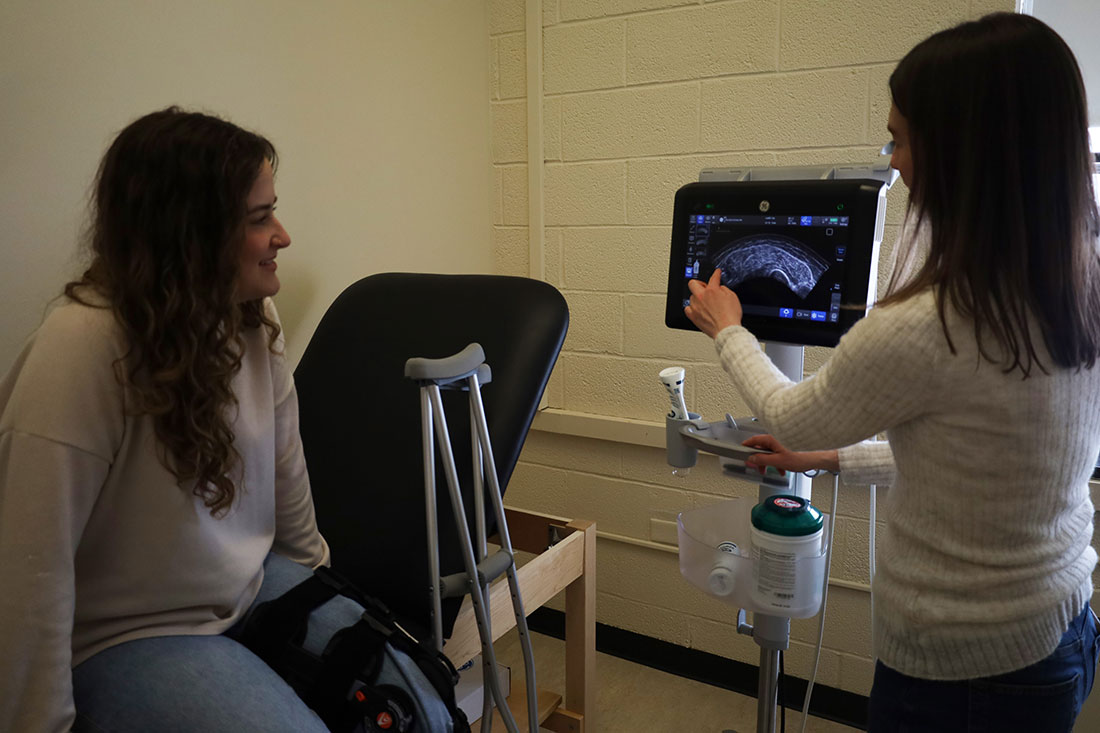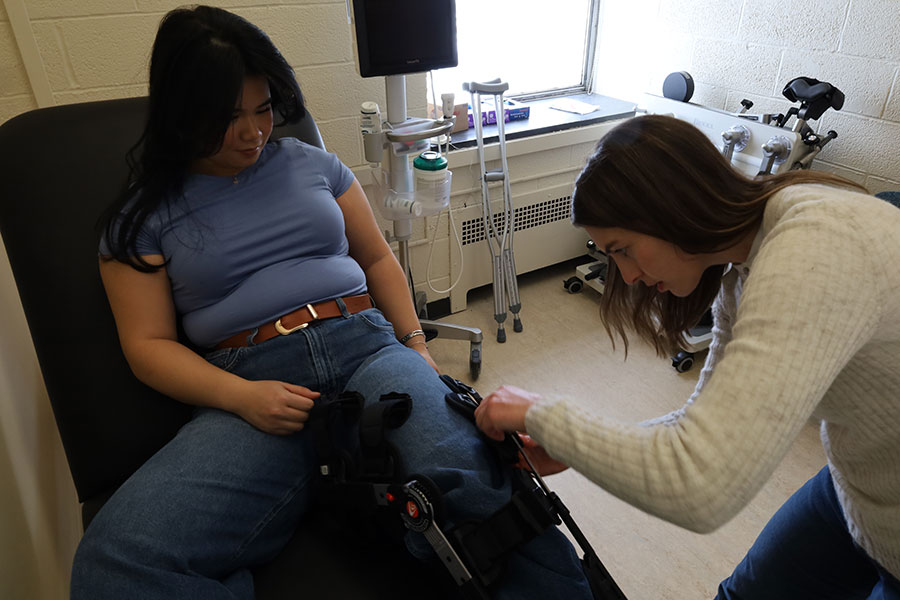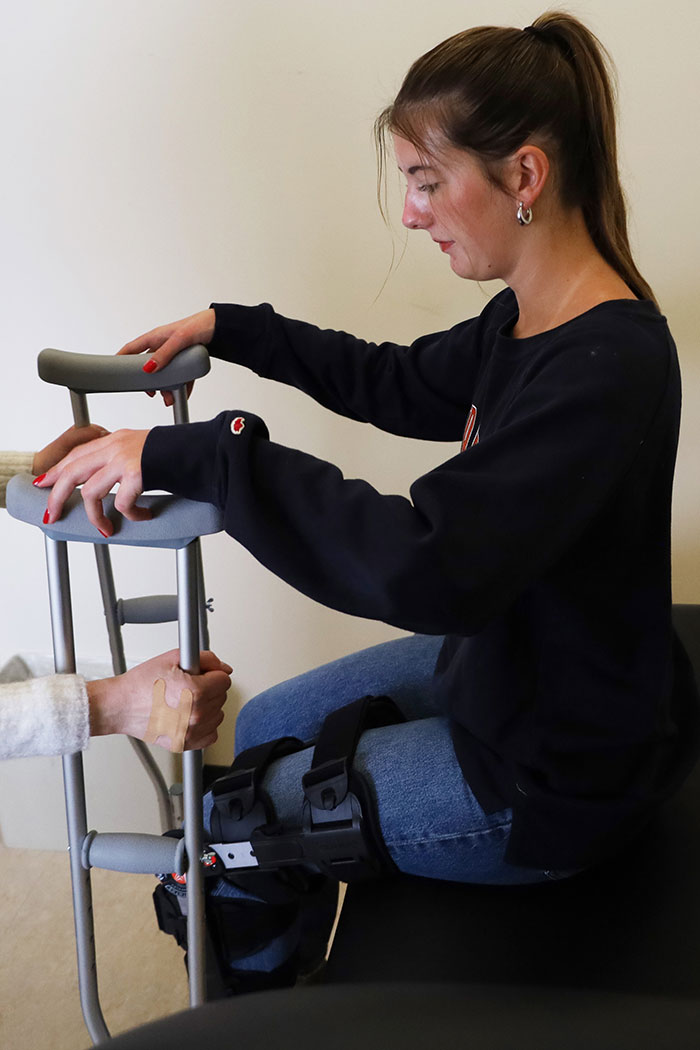
Kylie Harmon, an assistant professor in the Department of Exercise Science in the Falk College of Sport and Human Dynamics, has always been fascinated by this deep-rooted idea that a person could control a physical condition with their mind.
More specifically, she wondered if a person could use their mind to preserve muscle mass and strength during a prolonged period of immobilization. For Harmon, turning this idea into actual research was sparked by a published study where researchers used neuromuscular electrical stimulation on muscles immobilized in a cast to preserve leg strength and mass. Surprisingly, mass was preserved, but strength was not.
Harmon’s research found that given the role of the nervous system in immobilization-induced weakness, targeted interventions may be able to preserve muscle strength but not mass, and vice versa. Though preliminary, her findings highlight the specific nature of clinical interventions and suggest that muscle strength can be independently targeted during rehabilitation.
Harmon’s innovative research, which was conducted over several months and with nearly 40 participants, was published this past spring by the peer-reviewed scientific journal Experimental Physiology.
We sat down with Harmon to learn more about her research, most surprising findings, and next steps. Here’s that discussion:
What did you learn from the previous research on this topic and how did that frame what you wanted to accomplish with your research?

Those researchers saw that daily muscle stimulation helped to maintain muscle size, but didn’t impact muscle strength. In much of my work, I was using interventions that improved muscle strength, but had no impact on muscle size. I had some experience with action observation and mental imagery, which are neural intervention techniques in which a person observes muscular contractions or thinks about performing muscular contractions without actually doing so. These have been shown to be effective for strength gain or preservation, as they activate the neuromuscular pathways responsible for strength production. However, they don’t impact muscle size.
So, I thought it would be interesting to directly compare these two interventions – neuromuscular electrical stimulation versus action observation + mental imagery – to see if previous findings held up. We decided to design a lower-limb immobilization study with one group performing daily action observation + mental imagery to preserve strength, and another group performing daily electrical stimulation to preserve muscle size. The goals were twofold: 1) To further demonstrate that strength and size are distinct qualities and need to be addressed with specific interventions; and 2) To hopefully improve rehabilitation outcomes by preserving size and strength during immobilization.
Once you established your goals, how did you determine your research methods?
It took several months and a lot of teamwork to determine our methods. I relied heavily on existing literature to determine how to best implement lower-limb immobilization; what leg braces to use, what joint angle to immobilize at, and how long immobilization was needed before we would observe decreases in strength and size. I reached out to authors of my favorite papers to ask them about their methodologies, such as how to design an appropriate action observation + mental imagery intervention and what stimulation devices to buy.
Once I had a good idea of the game plan, I presented the idea to my mentors and collaborators to get their feedback. Finally, we developed a sizable research team to help with the project: three Ph.D. students, three M.S. students, four physical therapy students, and five undergraduate students. It was very much a team effort!
Can you describe the process of gathering your data?

We screened 117 interested people and when all was said and done, we had 39 individuals fully participate in the study. Prior to the immobilization week, we tested muscle strength, muscle size, and the ability of their brain to activate their muscles. We then had physical therapy students fit participants with a leg brace and crutches and show them how to navigate a variety of obstacles – opening doors, using stairs, sitting and standing.
During their week on crutches, participants had to wear accelerometers around both ankles so we could ensure that they were actually using the brace and crutches when away from the lab. We gave them a shower chair to assist in bathing, as they had to keep the brace on at all times except during sleep. We asked them to track the food that they ate. We also had a member of the research team call and check in on each participant every day during the immobilization week to make sure they were complying with study protocols and weren’t running into any issues.
In addition to immobilization, one group performed daily action observation + mental imagery using a guided video and audio recording, and another group performed daily neuromuscular electrical stimulation on their thigh muscles with a stimulation device we gave them.
We had participants return to the lab for a post-testing visit, and again re-tested their muscle strength, size, and neuromuscular function. If they lost strength (which almost everyone did), we had them come back to the lab twice a week for lower body resistance training until they regained their strength. We didn’t want them to leave the lab with weak, small muscles because of our experiment. Not very ethical! We ensured they were recovered, and published that data as well. Amazingly, no one dropped out during the leg immobilization, and we had 100% compliance!
Understanding this is preliminary and more research needs to be done, what can you say so far about your findings?
Yes, this is certainly preliminary, and I have additional avenues to explore and methodologies to perfect. However, our hypotheses were partially confirmed. Although daily muscle stimulation didn’t preserve muscle size, daily action observation and mental imagery did appear to preserve muscle strength to some extent based on our observed effect sizes. Although participants in the action observation + mental imagery group lost the most muscle mass, their dynamic strength increased by ~7%.
It’s pretty exciting to see that muscle strength – which is so important for overall function and health – can be preserved just by watching and thinking about performing muscular contractions. Our findings also help to confirm that while muscle strength and muscle mass are of course closely related, they are indeed different components and need to be addressed as such.
What is the potential impact of this research across the lifespan, and for short-term and long term immobilizations?

What I find so exciting about action observation + mental imagery interventions is how easily accessible they are. Anyone can watch a video and think about performing muscular contractions, and there is virtually no risk profile that I can think of. With how attached we all are to our devices, we have the ability to watch action observation videos in the palm of our hand; these techniques don’t require fancy equipment or trips to a rehabilitation clinic.
While more work certainly needs to be done to determine how these interventions work in longer immobilization periods and in immobilization with associated trauma (like a true injury or surgery), this is a very promising avenue of translational research that could be easily implemented into rehabilitation protocols. If we can preserve muscle strength during immobilization, rehabilitation timelines will decrease, which will result in lower total rehabilitation cost for patients. Hopefully with more research in this area, we can start to see these techniques be used more often in clinical settings.
What are your next steps with this research?
My next steps are to combine these interventions. Although we didn’t quite see muscle stimulation preserve strength, we did see that it was trending in that direction via some other muscular parameters. I’m interested in seeing if combining daily stimulation during action observation + mental imagery gives us even more robust results, and I’m working on a grant proposal to hopefully examine this in the future.
To learn more about academic programs, career opportunities, and research facilities in the Department of Exercise Science, visit the Falk College website.
